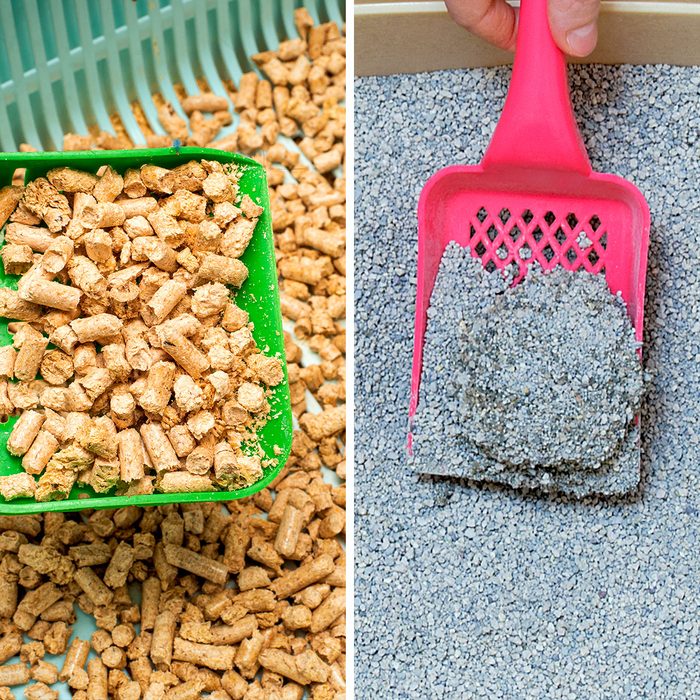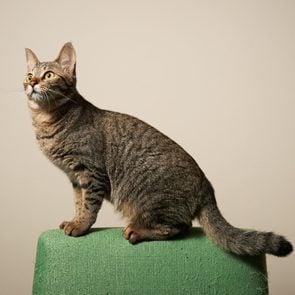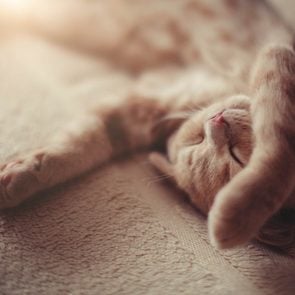Wood Cat Litter vs Clay Cat Litter: What’s the Difference?
Updated: Jan. 25, 2024

And find out which one may be better for your cat
Our editors and experts handpick every product we feature. We may earn a commission from your purchases.Learn more.
No one likes the cat’s litter box. It’s dirty, it’s hard to hide a litter box and it’s a pain to clean. And there’s always that lingering cat pee smell. But it’s just one of those facts of life for those of us with little furry four-legged friends. After years of trying various litter innovations—from clumping clay litter to self-cleaning litter boxes—I’ve found that far and away the best solution is wood cat litter.
Wood cat litter vs clay cat litter: What’s the difference?
Wood cat litter is made from wood pellets while clay cat litter is mostly made from bentonite clay that is broken down into particles.
When exposed to cat pee, the bentonite clay particles in clay cat litter absorb the moisture and stick together into clumps. Then you conveniently scoop out the clumps.
Wood cat litter is usually made from pine wood. Wood pellets are a very eco-friendly choice. They’re bio-degradable and a natural product usually made from recycled wood. Pine has a natural scent, so there’s no need for chemical fragrances to cover up odors. It’s compostable and lasts longer than typical clay cat litter, so you don’t have to change it as often.
How does wood cat litter work?
Woods like pine can absorb a cat’s urine—as much as four to seven times their weight in liquid — as well as neutralize the odor. As it absorbs the cat pee, it naturally turns into sawdust, which settles at the bottom of the box, leaving fresh pellets on top.
“With clumping litter, you let the dirty clumps stay in the scoop while the clean litter falls back in the box. But with wood pellets, we’re doing just the opposite and letting the dirty and broken-up pellets fall into a trash bag while the clean pellets stay on the scoop,” according to the website Better With Cats. The wood also masks the odor of solid waste, which sits on top and is easy to scoop. This video shows how to clean a box with wood pellets:
How does clay cat litter work?
Clay cat litter works similarly—the clay is what absorbs the cat’s urine. It separates the urine into clumps and does offer some natural odor control but as the litter becomes more soiled and can no longer absorb as well, odor can become an issue.
Clay cat litter is often scented with chemicals, and it can produce dust that can get tracked through your home, or ingested by your cat. According to the site PetKeen, “bentonite clay in clumping litter may cause problems for your cat if they ingest it. It can interfere with digestion by causing blockages in their stomach and intestine as it absorbs some of the liquids found inside their body.” I also find that clay cat litter doesn’t mask the odor as well as pine pellets.
The verdict?
Wood pellet cat litter, such as FelinePine or Ökocat, is the choice for a number of reasons, including smell, cleanliness, the safety of your pet and its impact on the environment. As Better With Cats explains, “When compared to clay litter, there’s really no contest. Wood pellet litter is easier on the environment, more cost-effective, it smells better and my absolute favorite is that it doesn’t track! That means no more picking litter off your feet anytime you step within 20 feet of your cat’s litter box. Even better, no more finding litter in places like your bed!”
Sources:


















